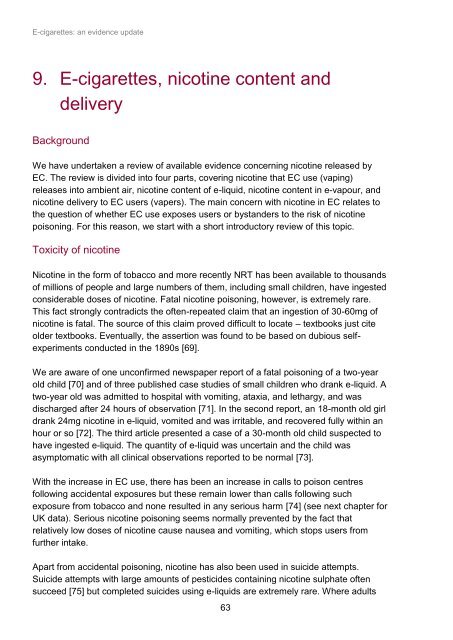E-cigarettes an evidence update A report commissioned by Public Health England
3nOaxpIe4
3nOaxpIe4
You also want an ePaper? Increase the reach of your titles
YUMPU automatically turns print PDFs into web optimized ePapers that Google loves.
E-<strong>cigarettes</strong>: <strong>an</strong> <strong>evidence</strong> <strong>update</strong>9. E-<strong>cigarettes</strong>, nicotine content <strong>an</strong>ddeliveryBackgroundWe have undertaken a review of available <strong>evidence</strong> concerning nicotine released <strong>by</strong>EC. The review is divided into four parts, covering nicotine that EC use (vaping)releases into ambient air, nicotine content of e-liquid, nicotine content in e-vapour, <strong>an</strong>dnicotine delivery to EC users (vapers). The main concern with nicotine in EC relates tothe question of whether EC use exposes users or <strong>by</strong>st<strong>an</strong>ders to the risk of nicotinepoisoning. For this reason, we start with a short introductory review of this topic.Toxicity of nicotineNicotine in the form of tobacco <strong>an</strong>d more recently NRT has been available to thous<strong>an</strong>dsof millions of people <strong>an</strong>d large numbers of them, including small children, have ingestedconsiderable doses of nicotine. Fatal nicotine poisoning, however, is extremely rare.This fact strongly contradicts the often-repeated claim that <strong>an</strong> ingestion of 30-60mg ofnicotine is fatal. The source of this claim proved difficult to locate – textbooks just citeolder textbooks. Eventually, the assertion was found to be based on dubious selfexperimentsconducted in the 1890s [69].We are aware of one unconfirmed newspaper <strong>report</strong> of a fatal poisoning of a two-yearold child [70] <strong>an</strong>d of three published case studies of small children who dr<strong>an</strong>k e-liquid. Atwo-year old was admitted to hospital with vomiting, ataxia, <strong>an</strong>d lethargy, <strong>an</strong>d wasdischarged after 24 hours of observation [71]. In the second <strong>report</strong>, <strong>an</strong> 18-month old girldr<strong>an</strong>k 24mg nicotine in e-liquid, vomited <strong>an</strong>d was irritable, <strong>an</strong>d recovered fully within <strong>an</strong>hour or so [72]. The third article presented a case of a 30-month old child suspected tohave ingested e-liquid. The qu<strong>an</strong>tity of e-liquid was uncertain <strong>an</strong>d the child wasasymptomatic with all clinical observations <strong>report</strong>ed to be normal [73].With the increase in EC use, there has been <strong>an</strong> increase in calls to poison centresfollowing accidental exposures but these remain lower th<strong>an</strong> calls following suchexposure from tobacco <strong>an</strong>d none resulted in <strong>an</strong>y serious harm [74] (see next chapter forUK data). Serious nicotine poisoning seems normally prevented <strong>by</strong> the fact thatrelatively low doses of nicotine cause nausea <strong>an</strong>d vomiting, which stops users fromfurther intake.Apart from accidental poisoning, nicotine has also been used in suicide attempts.Suicide attempts with large amounts of pesticides containing nicotine sulphate oftensucceed [75] but completed suicides using e-liquids are extremely rare. Where adults63


